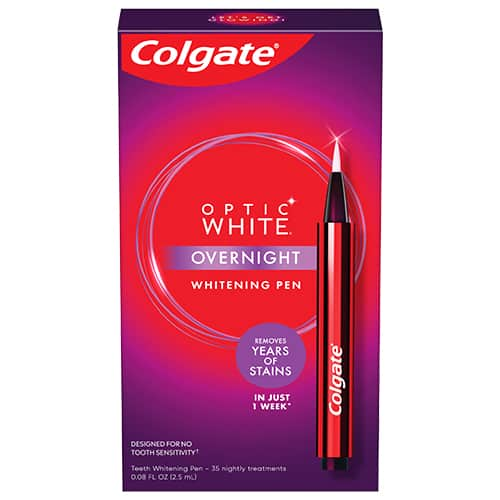If you have discolored or yellow teeth, you might be ready to join your fellow global citizens in whitening your teeth. If so, read on to learn about the different types of stains and what whitening options are best for each type. Even if you don't have a red carpet, you can prepare to dazzle with your smile.

Overnight Teeth Whitening Pen
Easy, effortless and effective teeth whitening while you sleep. Just click, apply and let the power of the enamel safe, hydrogen peroxide-based gel formula work overnight.

Types of Tooth Stain
At various times in your life, one of these three stain types might tarnish your smile.
1. Extrinsic Stains
Extrinsic teeth stains are those that discolor your enamel. This is the hard outer layer of each tooth that protects the softer dentin layer underneath. Here's how extrinsict stains develop…
Even though enamel is the hardest part of the tooth, it comes in contact with everything you put in your mouth – be it berries, red wine, or nicotine. Over time, your enamel absorbs some of the colors of the items you consume, causing a stain.
The good news is that extrinsic stains don't move below the enamel to the tooth's dentin. So, these stains are the easiest to remove with a home teeth-whitening system!
2. Intrinsic Stains
Intrinsic stains are those that begin inside the tooth and affect the dentin. They can happen for a number of reasons, including health conditions, medications, and trauma to the tooth. These stains are a little tougher to treat, but you may be able to remove them at home using a product with an active whitening ingredient like hydrogen peroxide or carbamide peroxide. A professional whitening treatment, though, might prove more effective.
3. Age-Related Stains
It's only natural that as you get older, your body changes. Your teeth are no exception, with your enamel getting thinner and your dentin turning a darker shade of yellow-brown.
As the enamel thins, the dentin starts to become more visible beneath, and your teeth might appear a darker shade as a result. Unfortunately, this is out of your control – no matter how diligent you've been with your oral hygiene.
Similar to intrinsic stains, age-related staining affects the dentin of your teeth. So, whitening techniques you'd use with intrinsic stains work best with aging teeth.
Removing Tooth Stains
Whether you'd like to remove extrinsic, intrinsic, or age-related stains, we've got you covered!
At-Home Whitening
The items below work best for extrinsic stains. But if the product you buy contains hydrogen peroxide or carbamide peroxide, it might work on intrinsic or age-related staining, too. Just be aware that those ingredients might cause teeth sensitivity.
Whitening toothpaste and mouthwash. You already brush your teeth twice daily and use mouthwash every day, so why not switch to whitening toothpastes and mouthwashes that are specially formulated to lift stains? Whitening toothpastes generally work by using abrasives to gently scrub stains from the surface. Some also include bleaching agents to remove deep-set stains, too.
Your teeth should become gradually whiter as the products lift off stains bit by bit, day by day.
If you use another quicker-acting teeth-bleaching product to take off stains (see below), you might also consider whitening toothpaste and/or mouthwash to keep your smile bright.Tooth whitening gel and trays. Available over-the-counter and in custom trays from your dentist, tooth whitening gels contain peroxide-based bleaching agents. You fill the accompanying trays (similar to gum shields) with whitening gel then place it over your teeth, taking care to avoid the sensitive gum tissue.
The gel contains higher amounts of peroxide than whitening toothpaste, so the whitening effect is stronger. Some kits also come with LED light devices to intensify the whitening effect.
Custom trays that you get from your dentist are made specifically to fit your teeth, so they are usually more effective and better at protecting your gums than over-the-counter kits. However, they are more expensive.Tooth whitening strips. This at-home method uses strips with pre-applied whitening gel for easy application without a tray. You simply stick the strips to your teeth and the gel bleaches them.
Be mindful that whitening strips can cause sensitivity if you opt for a product with high amounts of hydrogen peroxide or carbamide peroxide.
Follow the package directions very carefully and make sure you don't apply the strips over your gum line, as the gel might irritate the gum tissue.- Whitening pens. These pens contain bleaching gel that you brush onto your teeth in a thin layer. An excellent whitening solution for people on the go, a whitening pen fits in purses, pockets, and backpacks. And you have more control over where the gel goes with a pen than you do with whitening strips, so it’s easier to avoid the sensitive gum tissue.
In-Office Whitening
If your teeth stains won't budge with an at-home whitening option, no need to worry! Talk to your dentist about professional in-office whitening to remove deep stains from your teeth. Not only can your dentist use much stronger products than you can use at home, they also have access to technology like laser whitening to give you rapid and dramatic results.
Although this method can be the most efficient way to whiten discolored teeth, it can also be the most expensive course of action. If the price tag of a professional treatment concerns you:
Consider visiting a school for affordable dentistry.
Check to see if your area has a low-cost dental clinic that offers whitening services.
How to Remove Brown Stains From Teeth Naturally
Let’s talk specifically about brown stains – why might you have brown stains on your teeth? And more importantly, how can you remove them?
Why do I have brown stains on my teeth?
Brown teeth stains can often be caused by diet and lifestyle habits. Tobacco is a common cause, and darkly colored foods and drinks like coffee can stain your teeth brown, too.
Brown teeth stains can also be the result of poor oral hygiene, which leads to a build-up of plaque and tartar. These sticky substances attract all kinds of bacteria, food debris and staining particles, which can leave your teeth looking brown and dull. They can also lead to tooth decay and cavities, which may show up as brown spots or patches on your teeth.
Can brown stains on teeth be removed?
That depends on the cause. Brown staining from foods, drinks, or tobacco can be removed by cutting down on the culprit and improving your oral hygiene. For more stubborn stains, you may need at-home or professional whitening to remove brown stains.
For plaque or tartar, you’ll likely need to schedule a dental cleaning to remove the brown stains. And if you have tooth decay and cavities, these will need to be treated by your dentist. After any decayed brown tissue is removed and your tooth is restored, you’ll see a big improvement in the appearance of your smile, too.
Ways to remove brown stains from teeth naturally
What about natural options for removing brown stains? Well, there are lots of natural teeth whitening options that you may have heard about, such as strawberries and baking soda, orange peel rubbed on the teeth, and oil pulling with coconut oil.
Unfortunately we cannot recommend these home remedies for removing brown stains. Some, like coconut oil, are generally safe but don’t yet have much evidence to show that they work for removing stains. Others, like those that involve using fruits, are not only ineffective but can actually be harmful. Strawberries and oranges contain high levels of sugar and acids that can strip away your tooth enamel, making discoloration even worse.
To remove brown stains on your teeth, the best course of action is always a good oral hygiene routine, regular cleanings, and professionally formulated whitening products used on the advice of your dentist.
Now that you know all the types of teeth stains and how to safely remove them, you're set to DIY at home or spend some quality time in your dentist's chair. Talk with your dental professional about what option is best for you, and prepare to be a star in your own life with a dazzling smile!
This article is intended to promote understanding of and knowledge about general oral health topics. It is not intended to be a substitute for professional advice, diagnosis or treatment. Always seek the advice of your dentist or other qualified healthcare provider with any questions you may have regarding a medical condition or treatment.
ORAL HEALTH QUIZ
What's behind your smile?
Take our Oral Health assessment to get the most from your oral care routine
ORAL HEALTH QUIZ
What's behind your smile?
Take our Oral Health assessment to get the most from your oral care routine
Join Us
Get the best of your oral health routine and take it to the next level with expert advice, recommendations, products and solutions and special offers.
Join Us
Get the best of your oral health routine and take it to the next level with expert advice, recommendations, products and solutions and special offers.















